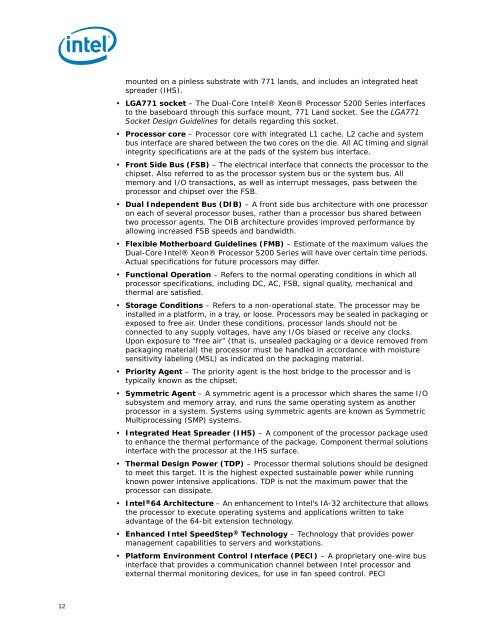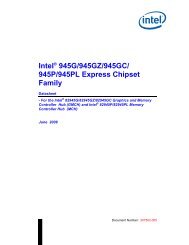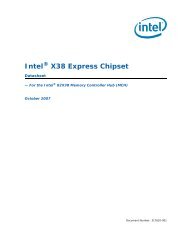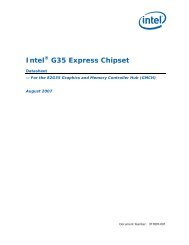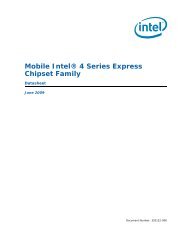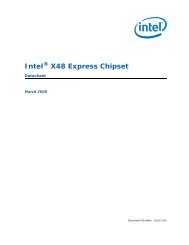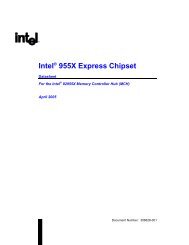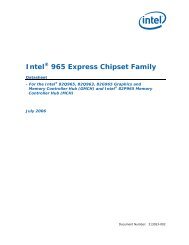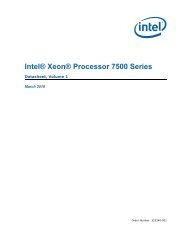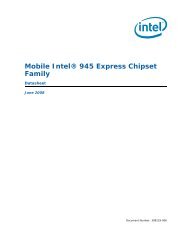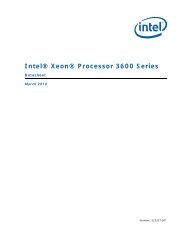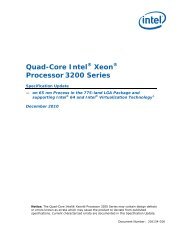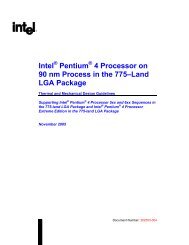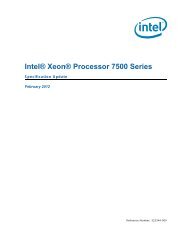Dual-Core Intel® Xeon® Processor 5200 Series
Dual-Core Intel® Xeon® Processor 5200 Series
Dual-Core Intel® Xeon® Processor 5200 Series
You also want an ePaper? Increase the reach of your titles
YUMPU automatically turns print PDFs into web optimized ePapers that Google loves.
12<br />
mounted on a pinless substrate with 771 lands, and includes an integrated heat<br />
spreader (IHS).<br />
• LGA771 socket – The <strong>Dual</strong>-<strong>Core</strong> <strong>Intel®</strong> <strong>Xeon®</strong> <strong>Processor</strong> <strong>5200</strong> <strong>Series</strong> interfaces<br />
to the baseboard through this surface mount, 771 Land socket. See the LGA771<br />
Socket Design Guidelines for details regarding this socket.<br />
• <strong>Processor</strong> core – <strong>Processor</strong> core with integrated L1 cache. L2 cache and system<br />
bus interface are shared between the two cores on the die. All AC timing and signal<br />
integrity specifications are at the pads of the system bus interface.<br />
• Front Side Bus (FSB) – The electrical interface that connects the processor to the<br />
chipset. Also referred to as the processor system bus or the system bus. All<br />
memory and I/O transactions, as well as interrupt messages, pass between the<br />
processor and chipset over the FSB.<br />
• <strong>Dual</strong> Independent Bus (DIB) – A front side bus architecture with one processor<br />
on each of several processor buses, rather than a processor bus shared between<br />
two processor agents. The DIB architecture provides improved performance by<br />
allowing increased FSB speeds and bandwidth.<br />
• Flexible Motherboard Guidelines (FMB) – Estimate of the maximum values the<br />
<strong>Dual</strong>-<strong>Core</strong> <strong>Intel®</strong> <strong>Xeon®</strong> <strong>Processor</strong> <strong>5200</strong> <strong>Series</strong> will have over certain time periods.<br />
Actual specifications for future processors may differ.<br />
• Functional Operation – Refers to the normal operating conditions in which all<br />
processor specifications, including DC, AC, FSB, signal quality, mechanical and<br />
thermal are satisfied.<br />
• Storage Conditions – Refers to a non-operational state. The processor may be<br />
installed in a platform, in a tray, or loose. <strong>Processor</strong>s may be sealed in packaging or<br />
exposed to free air. Under these conditions, processor lands should not be<br />
connected to any supply voltages, have any I/Os biased or receive any clocks.<br />
Upon exposure to “free air” (that is, unsealed packaging or a device removed from<br />
packaging material) the processor must be handled in accordance with moisture<br />
sensitivity labeling (MSL) as indicated on the packaging material.<br />
• Priority Agent – The priority agent is the host bridge to the processor and is<br />
typically known as the chipset.<br />
• Symmetric Agent – A symmetric agent is a processor which shares the same I/O<br />
subsystem and memory array, and runs the same operating system as another<br />
processor in a system. Systems using symmetric agents are known as Symmetric<br />
Multiprocessing (SMP) systems.<br />
• Integrated Heat Spreader (IHS) – A component of the processor package used<br />
to enhance the thermal performance of the package. Component thermal solutions<br />
interface with the processor at the IHS surface.<br />
• Thermal Design Power (TDP) – <strong>Processor</strong> thermal solutions should be designed<br />
to meet this target. It is the highest expected sustainable power while running<br />
known power intensive applications. TDP is not the maximum power that the<br />
processor can dissipate.<br />
• Intel ®64 Architecture – An enhancement to Intel's IA-32 architecture that allows<br />
the processor to execute operating systems and applications written to take<br />
advantage of the 64-bit extension technology.<br />
• Enhanced Intel SpeedStep ® Technology – Technology that provides power<br />
management capabilities to servers and workstations.<br />
• Platform Environment Control Interface (PECI) – A proprietary one-wire bus<br />
interface that provides a communication channel between Intel processor and<br />
external thermal monitoring devices, for use in fan speed control. PECI


